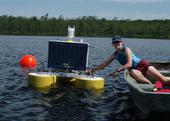Highlight
Profiling Buoy
Achievement/Results
Jennie Bentrup, EARS IGERT trainee, designed and constructed through a partnership with Fondriest Environmental, Inc. in Dayton, OH a profiling buoy with a sensor array which will be used to assess lake conditions. Jennie, Craig Williamson, and others plan to redeploy the buoy this summer after some improvements, and it is the primary buoy that they plan to use in a study of the continental scale network of lakes as sentinels of climate change. In order to better understand what occurs throughout the water column, Jennie worked with the Fondriest engineers to design and build a profiling buoy. Other IGERT trainees gained hands on exposure to this buoy during our annual workshop. The profiling buoy is equipped with sensors to study changes in dissolved oxygen, light, and chromophoric dissolved organic matter (CDOM), among others.
This buoy also was an integral technological component of an annual sensors workshop, Lacawac Ecological Observatory Workshop which was attended by 36 participants from 15 institutions and 4 countries. Our dependence on freshwater ecosystems is absolute. Globally, fresh water represents a small percentage (less than 2%) of the Earth’s surface area. Threats to aquatic systems (e.g., eutrophication, invasive species, climate change, acid rain) are numerous. Our reliance on the structure and function of fresh waters requires that scientists continually improve their tactics and technologies as exemplified by the profiling buoy developed for this project. Lakes themselves are valuable sensors in the landscape. As the lowest point in the surrounding landscape, they are particularly valuable sentinels of climate change. Advanced sensors, like the profiling buoy platform and sensory array, are critical for resolving the disproportionate impacts that short-term storm events have on lake ecosystems.
Address Goals
This activity addresses the strategic goals above by providing research capacity to examine critical environmental conditions in lakes. The technology also serves as a valuable research and education tool. For example, exposure of other IGERT trainees, students and faculty helps provide the foundation for future discoveries and inventions.







